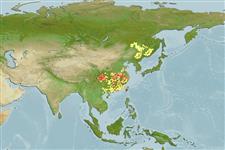Klassifizierung / Names
Common names from other countries
Hauptreferenz
Size / Gewicht / Alter
Max length : 105 cm TL Männchen/unbestimmt; (Ref. 40637); common length : 18.0 cm SL Männchen/unbestimmt; (Ref. 35840); max. veröff. Gewicht: 50.0 kg (Ref. 30578)
Length at first maturity
Lm 51.7 range ? - ? cm
Lebensraum
; süßwasser benthopelagisch; potamodrom (Ref. 51243); tiefenbereich 0 - 20 m (Ref. 6898)
Klimazone / Range
Subtropical; 6°C - 28°C (Ref. 37797), preferred ?; 64°N - 43°S
Verbreitung
Asia: Native to most major Pacific dainages of East Asia from Amur to Xi Jiang, China (Ref. 59043). China and Eastern Siberia. Introduced around the world for aquaculture and control of algal blooms. Several countries report adverse ecological impact after introduction (Ref. 1739). Often confused with Hypophthalmichthys nobilis (Ref. 59043).
Länder | FAO Gebiete | Ecosystems | Vorkommen | Einführungen
Kurzbeschreibung
Rückenflossenstacheln (insgesamt): 1 - 3; Rückenflossenweichstrahlen (insgesamt): 6-7; Afterflossenstacheln 1-3; Afterflossenweichstrahlen: 10 - 14. Body olivaceous to silvery. Barbels absent. Keels extend from isthmus to anus. Edge of last simple dorsal ray not serrated. Branched anal rays 12-13.5 (Ref. 13274). Differs from Hypophthalmichthys nobilis by having sharp scaleless keel from pectoral region to anal origin, 650-820 long, slender gill rakers, head length 24-29% SL, and plain pale coloration, greenish grey above, whitish below (Ref. 59043).
IUCN Rote Liste Status (Ref. 115185)
Bedrohung für Menschen
Potential pest
Nutzung durch Menschen
Fischereien: kommerziell; Aquakultur: kommerziell
Tools
Zusatzinformationen
Download XML
Internet Quellen
Estimates of some properties based on models
Phylogenetic diversity index
PD50 = 0.6250 many relatives (e.g. carps) 0.5 - 2.0 few relatives (e.g. lungfishes)
Trophic Level
2.0 ±0.00 se; Based on food items.
Widerstandsfähigkeit
mittel, Verdopplung der Population dauert 1,4 - 4,4 Jahre. (K=0.16-0.29; tm=2-6)
Verwundbarkeit
High vulnerability (55 of 100)
Preiskategorie
